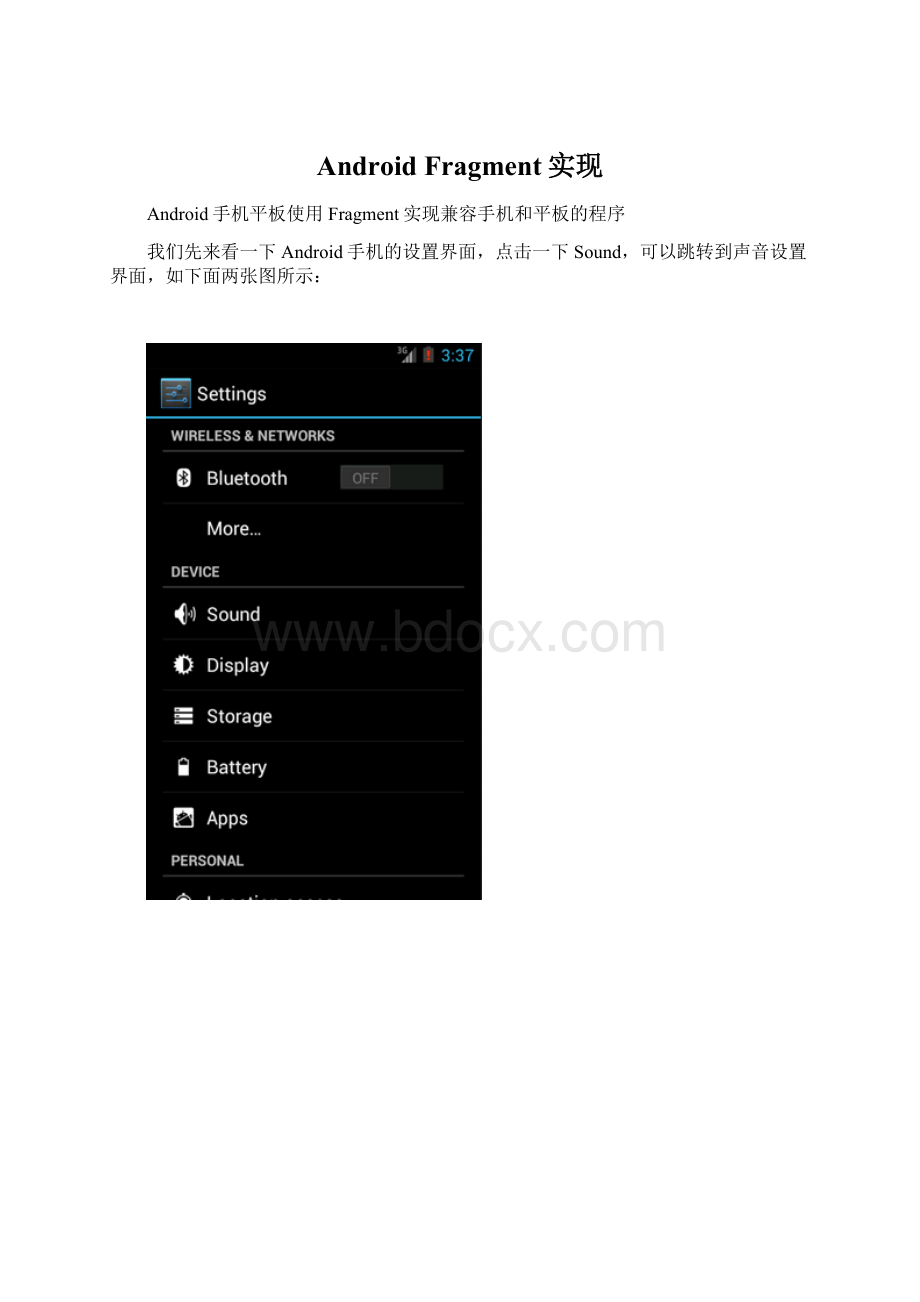Android Fragment实现.docx
《Android Fragment实现.docx》由会员分享,可在线阅读,更多相关《Android Fragment实现.docx(17页珍藏版)》请在冰豆网上搜索。

AndroidFragment实现
Android手机平板使用Fragment实现兼容手机和平板的程序
我们先来看一下Android手机的设置界面,点击一下Sound,可以跳转到声音设置界面,如下面两张图所示:
然后再来看一下AndroidPad的设置界面,主设置页面和声音设置页面都是在一个界面显示的,如下图所示:
如果这分别是两个不同的App做出的效果,那没有丝毫惊奇之处。
但如果是同一个App,在手机上和平板上运行分别有以上两种效果的话,你是不是就已经心动了?
我们现在就来模拟实现一下。
首先你需要对Fragment有一定的了解,如果你还没接触过Fragment,建议可以先阅读AndroidFragment完全解析,关于碎片你所需知道的一切这篇文章。
并且本次的代码是运行在Android4.0版本上的,如果你的SDK版本还比较低的话,建议可以先升升级了。
新建一个Android项目,取名叫FragmentDemo。
打开或新建MainActivity作为程序的主Activity,里面有如下自动生成的内容:
1.[java]viewplaincopyprint?
2. publicclassMainActivityextendsActivity{
3. @Override
4. publicvoidonCreate(BundlesavedInstanceState){
5. super.onCreate(savedInstanceState);
6. setContentView(R.layout.activity_main);
7. }
8. }
复制代码
作为一个Android老手,上面的代码实在太小儿科了,每个Activity中都会有这样的代码。
不过今天我们的程序可不会这么简单,加载布局这一块还是大有文章的。
打开或新建res/layout/activity_main.xml作为程序的主布局文件,里面代码如下:
1.[html]viewplaincopyprint?
2.
3. xmlns:
tools="
4. android:
layout_width="fill_parent"
5. android:
layout_height="fill_parent"
6. android:
orientation="horizontal"
7. tools:
context=".MainActivity">
8.
9. android:
id="@+id/menu_fragment"
10. android:
name="com.example.fragmentdemo.MenuFragment"
11. android:
layout_width="fill_parent"
12. android:
layout_height="fill_parent"
13. />
14.
15. 这个布局引用了一个MenuFragment,我们稍后来进行实现,先来看一下今天的一个重点,我们需要再新建一个activity_main.xml,这个布局文件名和前面的主布局文件名是一样的,但是要放在不同的目录下面。
16. 在res目录下新建layout-large目录,然后这个目录下创建新的activity_main.xml,加入如下代码:
17. [html]viewplaincopyprint?
18.
19. xmlns:
tools="
20. android:
layout_width="fill_parent"
21. android:
layout_height="fill_parent"
22. android:
orientation="horizontal"
23. android:
baselineAligned="false"
24. tools:
context=".MainActivity"
25. >
26.
27. android:
id="@+id/left_fragment"
28. android:
name="com.example.fragmentdemo.MenuFragment"
29. android:
layout_width="0dip"
30. android:
layout_height="fill_parent"
31. android:
layout_weight="1"
32. />
33.
34. android:
id="@+id/details_layout"
35. android:
layout_width="0dip"
36. android:
layout_height="fill_parent"
37. android:
layout_weight="3"
38. >
复制代码
这个布局同样也引用了MenuFragment,另外还加入了一个FrameLayout用于显示详细内容。
其实也就是分别对应了平板界面上的左侧布局和右侧布局。
这里用到了动态加载布局的技巧,首先Activity中调用setContentView(R.layout.activity_main),表明当前的Activity想加载activity_main这个布局文件。
而Android系统又会根据当前的运行环境判断程序是否运行在大屏幕设备上,如果运行在大屏幕设备上,就加载layout-large目录下的activity_main.xml,否则就默认加载layout目录下的activity_main.xml。
关于动态加载布局的更多内容,可以阅读Android官方提供的支持不同屏幕大小的全部方法这篇文章。
下面我们来实现久违的MenuFragment,新建一个MenuFragment类继承自Fragment,具体代码如下:
1.[java]viewplaincopyprint?
2. publicclassMenuFragmentextendsFragmentimplementsOnItemClickListener{
3. /**
4. *菜单界面中只包含了一个ListView。
5. */
6. privateListViewmenuList;
7. /**
8. *ListView的适配器。
9. */
10. privateArrayAdapteradapter;
11. /**
12. *用于填充ListView的数据,这里就简单只用了两条数据。
13. */
14. privateString[]menuItems={"Sound","Display"};
15. /**
16. *是否是双页模式。
如果一个Activity中包含了两个Fragment,就是双页模式。
17. */
18. privatebooleanisTwoPane;
19. /**
20. *当Activity和Fragment建立关联时,初始化适配器中的数据。
21. */
22. @Override
23. publicvoidonAttach(Activityactivity){
24. super.onAttach(activity);
25. adapter=newArrayAdapter(activity,android.R.layout.simple_list_item_1,menuItems);
26. }
27. /**
28. *加载menu_fragment布局文件,为ListView绑定了适配器,并设置了监听事件。
29. */
30. @Override
31. publicViewonCreateView(LayoutInflaterinflater,ViewGroupcontainer,BundlesavedInstanceState){
32. Viewview=inflater.inflate(R.layout.menu_fragment,container,false);
33. menuList=(ListView)view.findViewById(R.id.menu_list);
34. menuList.setAdapter(adapter);
35. menuList.setOnItemClickListener(this);
36. returnview;
37. }
38. /**
39. *当Activity创建完毕后,尝试获取一下布局文件中是否有details_layout这个元素,如果有说明当前
40. *是双页模式,如果没有说明当前是单页模式。
41. */
42. @Override
43. publicvoidonActivityCreated(BundlesavedInstanceState){
44. super.onActivityCreated(savedInstanceState);
45. if(getActivity().findViewById(R.id.details_layout)!
=null){
46. isTwoPane=true;
47. }else{
48. isTwoPane=false;
49. }
50. }
51. /**
52. *处理ListView的点击事件,会根据当前是否是双页模式进行判断。
如果是双页模式,则会动态添加Fragment。
53. *如果不是双页模式,则会打开新的Activity。
54. */
55. @Override
56. publicvoidonItemClick(AdapterView
>arg0,Viewview,intindex,longarg3){
57. if(isTwoPane){
58. Fragmentfragment=null;
59. if(index==0){
60. fragment=newSoundFragment();
61. }elseif(index==1){
62. fragment=newDisplayFragment();
63. }
64. getFragmentManager().beginTransaction().replace(R.id.details_layout,fragment).commit();
65. }else{
66. Intentintent=null;
67. if(index==0){
68. intent=newIntent(getActivity(),SoundActivity.class);
69. }elseif(index==1){
70. intent=newIntent(getActivity(),DisplayActivity.class);
71. }
72. startActivity(intent);
73. }
74. }
75. }
复制代码
这个类的代码并不长,我简单的说明一下。
在onCreateView方法中加载了menu_fragment这个布局,这个布局里面包含了一个ListView,然后我们对这个ListView填充了两个简单的数据"Sound"和"Display"。
又在onActivityCreated方法中做了一个判断,如果Activity的布局中包含了details_layout这个元素,那么当前就是双页模式,否则就是单页模式。
onItemClick方法则处理了ListView的点击事件,发现如果当前是双页模式,就动态往details_layout中添加Fragment,如果当前是单页模式,就直接打开新的Activity。
我们把MenuFragment中引用到的其它内容一个个添加进来。
新建menu_fragment.xml文件,加入如下代码:
1.[html]viewplaincopyprint?
2.
xmlversion="1.0"encoding="UTF-8"?
>
3.
4. android:
layout_width="fill_parent"
5. android:
layout_height="fill_parent">
6.
7. android:
id="@+id/menu_list"
8. android:
layout_width="fill_parent"
9. android:
layout_height="fill_parent"
10. >
复制代码
然后新建SoundFragment,里面内容非常简单:
1.[java]viewplaincopyprint?
2. publicclassSoundFragmentextendsFragment{
3. @Override
4. publicViewonCreateView(LayoutInflaterinflater,ViewGroupcontainer,BundlesavedInstanceState){
5. Viewview=inflater.inflate(R.layout.sound_fragment,container,false);
6. returnview;
7. }
8. }
复制代码
这里SoundFragment需要用到sound_fragment.xml布局文件,因此这里我们新建这个布局文件,并加入如下代码:
1.[html]viewplaincopyprint?
2.
3. android=" android:
layout_width="match_parent"
4. android:
layout_height="match_parent"
5. android:
background="#00ff00"
6. android:
orientation="vertical">
7. layout_width="wrap_content"
8. android:
layout_height="wrap_content"
9. android:
layout_centerInParent="true"
10. android:
textSize="28sp"
11. android:
textColor="#000000"
12. android:
text="Thisissoundview"
13. />
复制代码
同样的道理,我们再新建DisplayFragment和display_fragment.xml布局文件:
1.[java]viewplaincopyprint?
2. publicclassDisplayFragmentextendsFragment{
3. publicViewonCreateView(LayoutInflaterinflater,ViewGroupcontainer,BundlesavedInstanceState){
4. Viewview=inflater.inflate(R.layout.display_fragment,container,false);
5. returnview;
6. }
7. }
8. [html]viewplaincopyprint?
9.
10. android=" android:
layout_width="match_parent"
11. android:
layout_height="match_parent"
12. android:
background="#0000ff"
13. android:
orientation="vertical">
14. layout_width="wrap_content"
15. android:
layout_height="wrap_content"
16. android:
layout_centerInParent="true"
17. android:
textSize="28sp"
18. android:
textColor="#000000"
19. android:
text="Thisisdisplayview"
20. />
复制代码
然后新建SoundActivity,代码如下:
1.[java]viewplaincopyprint?
2. publicclassSoundActivityextendsActivity{
3. @Override
4. protectedvoidonCreate(BundlesavedInstanceState){
5. super.onCreate(savedInstanceState);
6. setContentView(R.layout.sound_activity);
7. }
8. }
复制代码
这个Activity只是加载了一个布局文件,现在我们来实现sound_activity.xml这个布局文件:
1. [html]viewplaincopyprint?
2.
3. android=" android:
id="@+id/sound_fragment"
4. android:
name="com.example.fragmentdemo.SoundFragment"
5. android:
layout_width="match_parent"
6. android:
layout_height="match_parent">
7.
复制代码
这个布局文件引用了SoundFragment,这样写的好处就是,以后我们只需要在SoundFragment中修改代码,SoundActivity就会跟着自动改变了,因为它所有的代码都是从SoundFragment中引用过来的。
好,同样的方法,我们再完成DisplayActivity:
1. [java]viewplaincopyprint?
2. publicclassDisplayActivityextendsActivity{
3. @Override
4. protectedvoidonCreate(BundlesavedInstanceState){
5. super.onCreate(savedInstanceState);
6. setContentView(R.layout.display_activity);
7. }
8. }
复制代码
然后加入display_activity.xml:
1.[html]viewplaincopyprint?
2.
3. android=" android:
id="@+id/display_fragment"
4. android:
name="com.example.fragmentdemo.DisplayFragment"
5. android:
layout_width="match_parent"
6. android:
layout_height="match_parent">
复制代码
现在所有的代码就都已经完成了,我们来看一下效果吧。
首先将程序运行在手机上,效果图如下:
分别点击Sound和Display,界面会跳转到声音和显示界面:
然后将程序在平板上运行,点击Sound,效果图如下:
然后点击Display切换到显示界面,效果图如下:
这样我们就成功地让程序同时兼容手机和平板了。
当然,这只是一个简单的demo,更多复杂的内容需要大家自己去实现了。